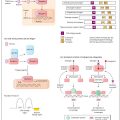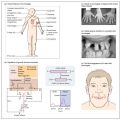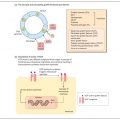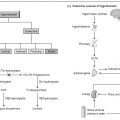Miss JP was referred to the paediatric endocrine clinic at the age of 14 years because her periods had not started and she was noted to be of short stature. On examination in the clinic she was found to be below the 3rd centile of height for her age. She had a number of dysmorphic features including a ‘webbed’ appearance to her neck, a wide carrying angle of the arms and widely spaced nipples with absent breast development (Fig. 23a). Turner syndrome was confirmed by the findings of raised gonadotrophin concentrations in the presence of an abnormal karyotype, 45XO. She was treated with low-dose ethinylestradiol and growth hormone to maximize growth, with subsequent increasing doses of estradiol to initiate pubertal development, followed by combined estrogen/ progestogens to maintain a menstrual cycle.
Sexual differentiation can be classified according to: (i) the genetic sex of the phenotype, that is whether it is XX or XY with respect to the sex chromosomes; and (ii) according to the sexual characteristics determined by the gonadal hormones (Fig. 23b). Every human normally has 46 chromosomes in each cell, consisting of 22 pairs of autosomal chromosomes, and a pair of sex chromosomes. Genetic sex is determined at the time of conception, when male and female gametes fuse to form a new individual. The possession of a Y chromosome determines that a male will develop, as the Y chromosome possesses the sex- determining gene, also called the Sry gene, which expresses the Sry antigen. The Sry antigen is a trigger that switches on genes on other chromosomes responsible for testicular development.
In the human fetus, at about 4 weeks, the gonads are indifferent, that is they cannot be distinguished as testis or ovary, and are capable of developing into either (Fig. 23c). The indifferent gonad before differentiation is composed of a coating of germinal epithelium, the genital ridge mesenchyme and the primordial germ cells. Thereafter, under the influence of the Sry antigen (Fig. 23d
Stay updated, free articles. Join our Telegram channel

Full access? Get Clinical Tree








